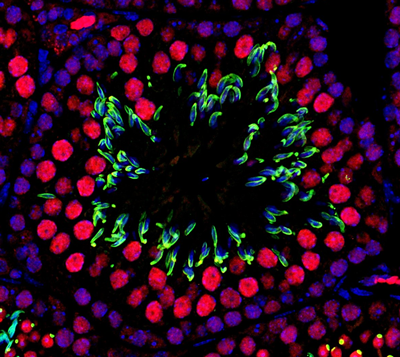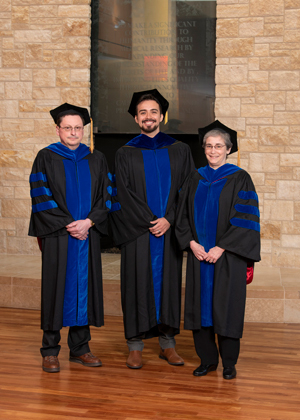In The News

07 January 2026
Investigator Kamena Kostova, named ‘Cell Scientist to Watch’
From the Journal of Cell Science, Investigator Kamena Kostova named a 'Cell Scientist to Watch'
Read Article
News
The Stowers Institute recognizes two decades of research, service, and achievements by Investigators Joan and Ron Conaway.

Ron and Joan Conaway, 2019
For twenty years, Ron and Joan Conaway have led a nationally recognized program at the Stowers Institute, but this year, they begin a journey down a new path. This summer, the Conaways will leave Stowers, and Kansas City, for their new home in Dallas, Texas.

Robb Krumlauf, Bill Neaves, Joan Conaway, and Ron Conaway, 2005
The Conaways joined the Institute in 2001, soon after the research campus opened. They were impressed with the facilities, but were more impressed by the vision for the Institute. Conversations with then-president and CEO Bill Neaves, then-Scientific Director Robb Krumlauf, and the founders, Jim and Virginia Stowers, were critical in helping the Conaways visualize what Jim Stowers said would be “the best place to do biomedical research in the world.” Their decision to join the Institute made a big impact, particularly on Krumlauf.
“Their decision was inspiring for Bill Neaves and me because it showed what the Stowers Institute could build for the future by attracting creative and exceptional scientists with a pioneering spirit,” Krumlauf says. “The Conaways have made an enormous impact on the Institute through their collegiality, creativity, intellect, scientific discoveries, and leadership. Their many contributions have played a major role in helping the Institute establish a highly-respected reputation in the international scientific community as a center for innovative research and impactful discoveries. Their spirit and contributions have shaped the Institute and we are proud to call them friends and colleagues.”
Joining a brand-new research institute in the Midwest may have seemed like a risk to some. At that time, many of the major biomedical research institutes were located on the US coasts. Joan and Ron believed strongly in the enormous potential of the Institute, though, and their good feelings paid off.

A predicted structure of a chromatin remodeling enzyme, ALC1, by Graducate School of the Stowers Institute Predoctoral Researcher Soon-Keat Ooi, 2017
“Everything has turned out better than we could have imagined,” says Joan. “The Institute has made an enormous investment in technology and has recruited spectacular researchers with whom we enjoy collaborating. We could not have accomplished what we have if not for our colleagues here.”
The focus on collaboration resonated with the Conaways, for whom teamwork is essential. The Conaways joined forces with many labs and departments while at Stowers, with the Proteomics Center being one of the first and most productive. Upon arrival, Ron and Joan lobbied for a mass spectrometry facility and within a few months, the Institute had delivered. The first samples were analyzed in 2003 and published in February 2004, kicking off a long series of joint projects between the Conaways and the Proteomics team.
“Our team will miss working with the Conaway Lab, especially their top-notch protein samples, but we are looking forward to writing up a few more manuscripts on the data we’ve acquired with them,” says Laurence Florens, head of Proteomics. “We wish them both good luck on the next phase of their illustrious careers.”
Another collaborator was Stowers Investigator Jerry Workman, who moved his lab to Stowers in 2002. Workman’s research, like the Conaways’, involves studying chromatin and gene expression.
“I have been extremely fortunate in having highly intelligent, friendly, and helpful colleagues in the form of Joan and Ron Conaway,” Workman says. “Their overlapping research interest and their collegiality have had a huge impact on the research in our lab and that of former lab members who now have their own labs. I cannot thank them enough for the past eighteen years of friendship and collaboration.”

A cross section of a seminiferous tubule of adult mouse testes by Postdoctoral Researcher Kyle Ingram, 2018
Joan and Ron met as graduate students at Stanford University. Prior to that, Joan received a bachelor’s degree in chemistry and biology at Bryn Mawr, and Ron earned a BA in physics and chemistry at Indiana University. Joan’s PhD mentor, Roger Kornberg, was the one who encouraged the two scientists to join forces to tackle a scientific mystery: the identity of the molecular factors that signal the RNA polymerase II to catalyze the transcription process.
Now, thirty years later, the pair is regarded as one of science’s most accomplished research teams who has advanced scientific knowledge about many of the mechanisms that underlie gene transcription. In addition to revealing how gene transcription occurs at the molecular level, the Conaways’ research has highlighted some of the steps in the process that may play a role in cancer and other diseases. Their productivity has resulted in over 180 co-authored publications.
“Joan and I have been able to do this enough times to keep me really happy,” Ron jokes.
Both Conaways have received multiple accolades during their career, including receiving the ASBMB–Amgen Award in 1997 and being inducted into the American Academy of Arts of Sciences in 2002. In 2005, they were acknowledged by the Nature editorial board for having been responsible for one of the 20 major landmark discoveries in the 25-year history of how gene expression is regulated.

Ron Conaway, Joan Conaway, Virginia Stowers, and Jim Stowers Jr. at a ten-year employee recognition event, 2012
Additionally, Joan was a Howard Hughes Medical Institute investigator from 1997 to 2001, an appointment that provided generous funding and which she forfeited to join the Stowers Institute. While at Stowers, Joan was named the first holder of the Helen Nelson Distinguished Chair and received an annual endowment to support her research. Most recently, in 2020, Joan was elected to the prestigious National Academy of Sciences.
For the first time in many years, Joan and Ron’s paths will diverge slightly. In Dallas, Joan will take on a new role as the Vice Provost and Dean of Basic Research at The University of Texas Southwestern Medical Center. She will also be appointed Professor of Molecular Biology and hold the Cecil H. Greene Distinguished Chair in Cellular and Molecular Biology. Ron will retire, allowing more time for interests apart from science, though he knows there will be things about conducting research that he’ll miss.
“As a scientist, I have been able to talk about research problems with other people in the lab and conduct experiments to determine whether the ideas we come up with were correct. I’ll likely miss that,” he says.
At Stowers, the Conaways’ presence will be missed, not just for their scientific expertise, but for the traits admired by Jim and Virginia Stowers: cooperative, generous with their time and talent, and committed to a goal larger than individual success.
About two years ago, when Ron and Joan first decided they would close their lab at Stowers, they focused more on their lab members than their own next steps. They helped them finish research projects and training, then did what they could to help them line up their next positions as much as possible. Joan and Ron want to ensure their lab members “have the best chances of having a happy and productive future in science,” says Ron.

Ron Conaway, Melvin Noé González, Joan Conaway, 2019 GSSIMR Graduation
That unstinting support for other researchers is par for the course with the Conaways, who have impacted many people during their time at Stowers.
“In my life, there are just a few people who have influenced me so greatly that they changed my life-course,” says Tari Parmely, director of Cellular, Tissue, and Molecular Biology. “Ron and Joan are two of those people. They hired me into their laboratory in 2002 and I spent six years in their lab before moving into the core labs with their support.”
“Joan, in particular, has been a great mentor to me in leadership,” Parmely continues. “Joan modeled for me how to be a leader who is patient and generous with others. Joan and Ron together showed me how to build a team with different strengths and to allow that team space to learn and grow. They modeled for all of us how to BE a team in the way that they shared responsibilities according to their strengths.”
Joan maintains that she and Ron have been lucky enough to work with terrific people throughout their career. While that may be true, those who have worked with the Conaways likely believe that they are in fact the lucky ones.
“It was truly an honor to support the Conaway Lab,” says Jay Casillas, senior systems administrator. “Joan and Ron have always treated me and everyone in IT with utmost respect. It’s like watching family move away and hurts just the same.”

Joan and Ron Conaway in their lab, 2006
In The News

07 January 2026
From the Journal of Cell Science, Investigator Kamena Kostova named a 'Cell Scientist to Watch'
Read Article
#Stowers25: Celebrating 25 Years
06 January 2026
Alejandro Sánchez Alvarado, Ph.D., reflects on a year of discovery, gratitude, and the community that helps support our mission.
Read Article
In The News

01 January 2026
From Science Friday, President and CSO Alejandro Sánchez Alvarado talks about the science of regeneration and the biology lessons we can carry into the new year.
Read Article
